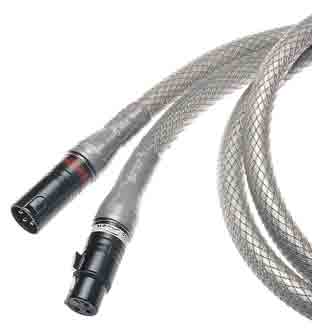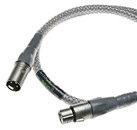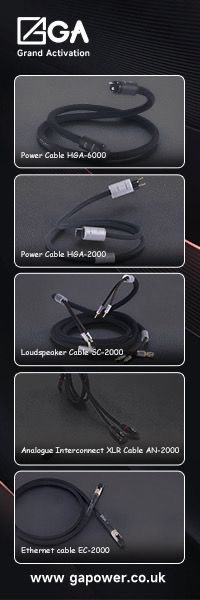ACOUSTIC ZEN CABLES
| ACOUSTIC ZEN CABLES |
|
Silver Crystal Reference |
|
Lewis Lanese |
|
July 2004 |

Evaluating interconnects, speaker cables and the like is surely one of the most difficult tasks a reviewer has to face. Many years ago, when I was a budding audiophile, the prospect of connecting up my equipment was “a no-brainer”. Back in the late ‘50s, early ‘60s, for example, I owned a Garrard Turntable, SME 3009 pick-up arm, Decca stereo cartridge (called the Head), and Quad preamp, amps and electrostatic speakers. I purchased some lamp cord at the local hardware store to connect the Quad Series II tube amps to the Quad Electrostatic Speakers. Usually the manufacturers of the source components provided the necessary interconnects. The life of an audiophile was simple until later when I learned that the capacitance, inductance and resistance of cables could adversely affect the sound of the system.
There are no perfect cables

In a STEREO TIMES review I did several years ago, I wrote, “I have no doubts about certain interconnects working better than other interconnects with particular electronics or certain speaker cables being a better marriage with particular speakers. The question of inductance, impedance and capacitance is foremost in matching components for the best performance e.g. speaker cable with a very high impedance could alter the frequency response of a speaker whose input impedance is very low when the output [i.e. source] impedance of a given amplifier is very high (not unusual with some tube amps).”
Generally the capacitance, inductance and resistance of cables should be as low as possible. Robert Lee, owner and design engineer of Acoustic Zen Technologies notes:
“There are no perfect cables out on the market today… The amplitudes and the phase relationships of voltages and current in a cable are dependent on a combination of the value of resistance, the series inductive reactance, and the parallel capacitive reactance. Such intricate parameters of cable design often result in signal loss, signal distortion and phase shifts in frequency.”
I met Lee about five years ago at the CES in Las Vegas. He and Jim Wang started a company called Harmonic Technology. I spent some time talking to Robert and was very impressed with his knowledge of metallurgy and the application that went into the design of his cables. The cables he and Jim sent me for review were a revelation. Since then, Robert Lee left Harmonic Technology to start his own company and to pursue his research in “…the refinement and constitution of metals…” that has led to the design of his latest Zero Crystal wires and cables.
Cable Design

Robert Lee, who is a metallurgist, uses pure silver and copper that has been processed in such a way as to eliminate the formation of crystals and impurities so that there is only one crystal per 150 meters of cable compared to 6,000 crystals per meter common to some other high-end cables. Lee claims, “This difference is significant and absolutely improves electron transmission resulting in clarity and smoothness of sound.” Robert, who is an accomplished pianist and violinist, brings his musical knowledge to bear as well in his judgment of the results.
Acoustic Zen cables use multi-stranded conductors to eliminate electromagnetic interference. To reduce phase shift and frequency distortion, capacitance is kept very low by using Teflon, polyethylene foam and air as the dielectric and controlling the distance between a pair of wires. Also, Constant Air-Twisting technology contributes to the low capacitance. To keep inductance very low, attention is directed toward correct conductor sizes and distances and twists of pairs of conductors.
[Resistance (R) is a variable crucial to the cables’ architecture. The formula for R is as follows:]

Until lately, most of my equipment was single-ended design except the Ayon Audio 52-B Reference Monoblocks which provide both single-ended, RCA and balanced, XLR inputs. Since the Croft Dual Mono Preamp has only single-ended inputs and outputs, in all of my previous reviews I have used single-ended interconnects. Recently, however, this changed.
In my last review (June 2004) for STEREO TIMES, I evaluated the TEAC Esoteric P-70 CD Transport and D-70 D/A Converter. TEAC recommends balanced interconnects in the setup although single-ended interconnects may be used. Since the D-70 has its own digital volume control, the Esoteric provides direct connection to the monoblocks bypassing the line stage. Moreover, Musical Surroundings provided me with the Aesthetix Calypso Line Stage for audition. The Calypso has both single-ended and XLR inputs and outputs. At $14,000 for the P-70/D-70, I opted to follow TEAC’s cable recommendation to provide a thorough evaluation.
Acoustic Zen provided me with the following cables for the review:
MC/2 Zero Crystal Silver Digital Reference – 2 XLR balanced 110 ohm cables for AES-3 digital connections.
Silver Bytes Zero Crystal Digital Reference – 75 ohm Coaxial BNC terminated cable.
Zero Crystal Silver Reference II – 2-3 1/2 meter XLR balanced interconnect cables.
Zero Crystal Silver Reference II – 2-10 meter XLR balanced interconnect cables.
Double Barrel 6N Zero Crystal Copper: 10 AWG High Pass; 8 AWG Low Pass – 3 1/2 meter (bi-wire) speaker cable.
Listening Experience
I used Purist Audio Design’s CD, System Enhancer, to break in the cables although excessively long burn-in doesn’t seem to be significant with Robert Lee’s latest products. Dan Dzuban, in his ST Acoustic Zen review nearly two years ago, commented on the long burn-in time required. I attribute the difference in his experience to the earlier Zen products. After 40 hours, I began to listen in earnest.
“I have never heard such a wide and deep stereo stage from my system! And for the first time in all the years listening to my system, the speakers completely disappeared…. I don’t expect to hear a superior CD combination in the near future.” This is how I concluded my comments on the Esoteric. Most of my CD evaluation was with the D-70 connected directly to the monoblocks with the shorter XLR interconnects. Yes Robert, you are right – there is an exceptional clarity and smoothness of sound. But what changes would occur with the 10-meter interconnects?
Despite some very careful listening, I was unable to detect any difference whether I used the long or short cables. This was born out when I placed the Calypso line stage between the D-70 and the amps. The Aesthetix added a slight heft to the mid-bass but this was the case with either set of cables.
I was not disappointed when I switched to vinyl and fm. The Aesthetix Calypso was connected to the amps with the 10-meter cables. Although the stereo stage was not quite as wide and deep as that from the Esoteric, the speakers did disappear.
Conclusion
Smoothness, clarity, detail, deep and dynamic bass, rich midrange, extended treble and a wide and deep stereo stage – all of the elements one strives for in a system came through.
I honestly don’t believe that I could have come to that conclusion without the near perfect synergy between the Acoustic Zen cables and the rest of the system. The Acoustic Zen are now my reference cables!
Acoustic Zen has a whole range of cable and prices to fit your finances. You owe it to yourself to add the Acoustic Zen cables to the list of cables you plan to audition. They may provide the near perfect compliment to your system.
Specifications:
MC2=Zen Zero Crystal Silver 110 Ohm Digital, 1.0 meter w/RCA/BNC plug Price: $298.00/M
Silver Bytes 75 Ohm Coaxial BNC, Zero Crystal Silver, 1.0 meter w/RCA/BNC plug Price: $198.00/M
7N Zero Crystal Silver, w/XLR plug
Unit: Pair / 1.0 meter
Price: $ 998.00/M
Plus $ 600.00/M for longer cable, 15% off for 0.5 meter cable.
Double Barrel 8AWG, 6N Zero Crystal Copper For Low Pass, 10AWG For Mid-Hi Pass Plus $180.00/ft for longer cable, minus $90.00/ft for shorter cable.
$1,868.00/per eight foot pair
Address:
Acoustic Zen Technologies
800 Los Vallecitos Blvd
Suite P
San Marcos, CA 92069
Email: infozen@acousticzen.com
Phone: 760-471-4899
Website: http://www.acousticzen.com
![]()
Don’t forget to bookmark us! (CTRL-SHFT-D)
Stereo Times Masthead
Publisher/Founder
Clement Perry
Editor
Dave Thomas
Senior Editors
Frank Alles, Mike Girardi, Russell Lichter, Terry London, Moreno Mitchell, Paul Szabady, Bill Wells, Mike Wright, and Stephen Yan,
Current Contributors
David Abramson, Tim Barrall, Dave Allison, Ron Cook, Lewis Dardick, John Hoffman, Dan Secula, Don Shaulis, Greg Simmons, Eric Teh, Greg Voth, Richard Willie, Ed Van Winkle, Rob Dockery, Richard Doron, and Daveed Turek
Site Management Clement Perry
Ad Designer: Martin Perry





Be the first to comment on: ACOUSTIC ZEN CABLES